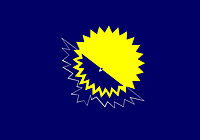Andean Parliament
|
Andean Parliament Parlamento Andino |
|
|---|---|
 |
|
| History | |
| Founded | October 25, 1979 |
| Leadership | |
|
President
|
Edith Fernández Mendoza (Bolivia), Colombian Liberal Party
|
|
Vice-President
|
Romilio Gutiérrez Pino (Chile), Movement for Socialism
|
|
Vice-President
|
Juan Carlos Restrepo (Colombia), Socialist Party – Broad Front of Ecuador
|
|
Vice-President
|
Cecilia Castro Márquez (Ecuador), Christian People's Party
|
|
Vice-President
|
Rolando Sousa (Perú)
|
| Seats | 25 deputies |
| Meeting place | |
| Bogotá | |
| Website | |
| www |
|
The Andean Parliament is the governing and deliberative body of the Andean Community. It was created on October 25, 1979 in La Paz (Bolivia), through the Constitutive Treaty signed by the chancellors of Bolivia, Colombia, Ecuador, Peru and Venezuela. It entered into force in January 1984.
The Andean Parliament has a Headquarter, located in Bogotá (Colombia), administered by the Secretary General. In addition, each country has a National Headquarters. These serve as liaison and coordination bodies.
It represents the 120 million inhabitants of the Andean Region, whose member states are Bolivia, Colombia, Ecuador, Peru and Chile (which joined in 2015).1
Its main functions include legislative harmonization in its member countries, permanent and active representation of the peoples of the region, guaranteeing their participation and strengthening of the integration process, and parliamentary management through the political control of institutions Of the Andean Integration System (IAS). (Cartagena Agreement, Art. 43)
The Andean Parliament is the political organ, deliberative, representative of the people, as well as guarantor of the rights and democracy in the Andean Community. Subsequently, in 1996, through the Trujillo Protocol modifying the Cartagena Agreement, the governments of the subregion granted it supranational powers, defining it as the Political Control Unit of the Andean Integration System (SAI).
The origins of the Andean Parliament go back to 1966 with the Bogotá Agreement, drawn up on the recommendation of ECLAC under the Montevideo Treaty of 1960. With the Cartagena Agreement, signed on May 26, 1969, the five countries met In what was originally called the Andean Pact, when its legal norms and provisions were established.2 Its objective was to strengthen its economies through free trade, tariff elimination and the customs union. Its Constitutive Treaty was signed by the chancellors of Bolivia, Colombia, Ecuador, Peru and Venezuela. Its first headquarters was Lima, although later it moved to Bogota.
Its representatives were initially elected by the national congresses of the member countries. According to the Protocol of Trujillo, approved on March 10, 1996, its representatives would be elected for a period of five years directly by the respective member countries of the Andean Community; In Colombia they were by direct suffrage since the elections of March 14, 2010. It consisted of five members for each member country, which gave a total of twenty-five parliamentarians.
On April 22, 2006, Venezuela withdraws from the Andean Community and, therefore, also from the Andean Parliament, denouncing the Treaty Establishing the Cartagena Agreement. The reason given was the signing by Colombia and Peru of free trade agreements with the United States which distorted the CAN, according to the Venezuelan government. Later the Colombian legislature through law 1157 of 2007, which allowed the election in this country of these parliamentarians by means of universal and direct suffrage, approved the salaries and commissions of the Andean parliamentarians that would be paid with part of the budget of the State, when before they sat Free of charge.
...
Wikipedia
